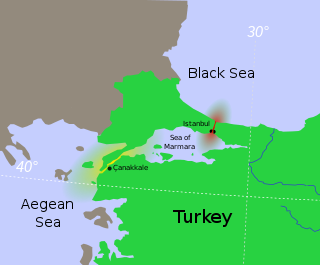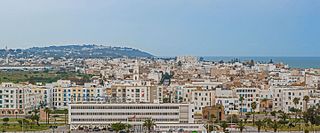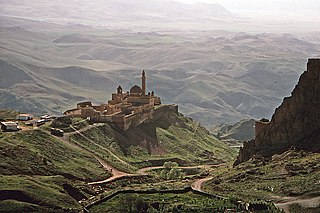
The Bosporus or Bosphorus Strait is a natural strait and an internationally significant waterway located in Istanbul, Turkey. The Bosporus connects the Black Sea to the Sea of Marmara and forms one of the continental boundaries between Asia and Europe. It also divides Turkey by separating Asia minor from Thrace. It is the world's narrowest strait used for international navigation.

The Russo-Turkish War was a conflict between the Ottoman Empire and a coalition led by the Russian Empire which included Romania, Serbia, and Montenegro. Additional factors included the Russian goals of recovering territorial losses endured during the Crimean War of 1853–1856, re-establishing itself in the Black Sea and supporting the political movement attempting to free Balkan nations from the Ottoman Empire.

Dolmabahçe Palace located in the Beşiktaş district of Istanbul, Turkey, on the European coast of the Bosporus strait, served as the main administrative center of the Ottoman Empire from 1856 to 1887 and from 1909 to 1922.

Göreme is a town (belde) in the Nevşehir District, Nevşehir Province in Central Anatolia, Turkey. Its population is 2,034 (2022). It is well known for its fairy chimneys, eroded rock formations, many of which were hollowed out in the Middle Ages to create Christian churches, houses and underground cities. Göreme was formerly known as Korama, Matiana, Macan and Avcilar.
Andron or andronitis is part of a Greek house that is reserved for men, as distinguished from the gynaeceum, the women's quarters. The andrōn was used for entertaining male guests. For this purpose the room held couches, usually an odd number to allow space for the door, tables which could be tucked under the couches, artwork and any other necessary paraphernalia. Not all classical Greek houses were large enough to have a dedicated andrōn, and even those that did might have used the room for mixed-gendered events and women receiving female guests, as well as men hosting symposia.

La Goulette, in Arabic Halq al-Wadi, is a municipality and the port of Tunis, Tunisia.

Ishak Pasha Palace is a semi-ruined palace and administrative complex located in the Doğubeyazıt district of Ağrı province of eastern Turkey.

The Beylerbeyi Palace is located in the Beylerbeyi neighbourhood of Üsküdar district in Istanbul, Turkey, at the Asian side of the Bosphorus. An imperial Ottoman summer residence built between 1861 and 1865, it is now situated immediately north of the first Bosphorus Bridge. It was the last place where Sultan Abdulhamid II was under house arrest before his death in 1918.

Hala Sultan Tekke is a mosque and takya on the west bank of Larnaca Salt Lake, in Larnaca, Cyprus. Umm Haram, known as Hala Sultan in Turkish tradition, was the wife of Ubada bin al-Samit, a companion of the Islamic prophet Muhammad, and foster sister of Muhammad's mother, Amina.
In pre-Atatürk Turkey, a haremlik was the private portion of upper-class Ottoman homes, as opposed to the selamlik, the public area or reception rooms, used only by men in traditional Islamic society. This contrasts with the common usage of harem as an English loan-word, which implies a female-only enclave or seraglio. Although the women of the household were traditionally secluded in the haremlik, both men and women of the immediate family lived and socialized there.

The Battle of Doliana occurred on 30 May 1821 N.S. during the Greek War of Independence when Greek revolutionaries defeated the forces of the Ottoman Empire at Doliana in the Morea province of the Ottoman Empire.

Ramazanoğlu Hall is the old government residence of the Ramadanids located in Adana. Currently used as a cultural center, it is one of the oldest examples of a mansion in Turkey. Located southeast of the Ulu Camii, it was the Harem of the Ramadanid family and besides being a fine expression of modesty of the emirate, it is also an important work resembling the Mamluk mansions of Egypt.

The Abdullah Frères were a group of three Ottoman brothers of Armenian descent, Viçen Abdullahyan (1820–1902), Hovsep Abdullahyan (1830–1908), and Kevork Abdullahyan (1839–1918), photographers of international fame during the late Ottoman Empire. They took pictures of scenic views and notable individuals, including sultans. Most of their photography was taken in the Ottoman Empire.

The Ioannina Castle is the fortified old town of the city of Ioannina in northwestern Greece. The present fortification dates largely to the reconstruction under Ali Pasha in the late Ottoman period, but incorporates also pre-existing Byzantine elements.

Büyük Hamam is a Turkish bath in the Iplik Bazar–Korkut Effendi quarter of North Nicosia. It stands close to the İplik Pazarı Mosque. As a result of the rise of the ground of the surrounding areas over time, its door is now located around 2 meters below the ground level, and the bath rooms are 3 meters below.

Dervish Pasha Mansion is a historical mansion and ethnographic museum in the Arab Ahmet quarter of Nicosia, currently located in North Nicosia. It lies on the Beliğ Paşa Street and has two floors. It is considered to be one of the finest examples of Ottoman architecture in Cyprus.

The residential architecture in Historic Cairo covers the area that was built during the Fatimid, Ayyubid, Mamluk, Ottoman, French occupation and even Mohamed Ali periods. Historic Cairo covers an area of around 523.66 ha on the eastern bank of the Nile river and is surrounded by the modern quarters of Greater Cairo. First report of activities of Urban Regeneration Project for Historic Cairo set a map to compare the world heritage property and buffer zone in different institutions such as (URHC) & Supreme Council of Antiquities (SCA).
Naile Sultan was an Ottoman princess, the daughter of Sultan Abdul Hamid II and Dilpesend Kadın.

Debbane Palace, also Qasr Debbane, Dar Ali Agha al-Hammud, and Dar Debbané, is an Arab-Ottoman-style grand mansion in Sidon, Lebanon. The palace was built as a private residence in 1721 by Ali Agha al-Hammud, a Sidonian notable descending from a long line of builders. The palace was built around a central courtyard without any street-level openings to ensure the privacy of its occupants. Only the reception area or selamlik remains of the palace's original wings; it features an indoor fountain, elaborate multicolored mosaics, muqarnas ornaments and sculpted Lebanese cedar ceilings.
The culture of Urfa, Turkey is diverse and spans cuisine, literature and language.
















